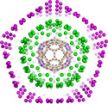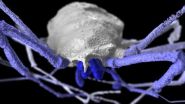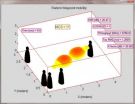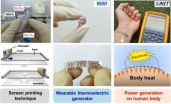(Press-News.org) Surgery for frail, senior citizen patients can be risky. A new patient-centered, team-based approach to deciding whether these high-risk patients will benefit from surgery is championed in an April 10 Perspective of the New England Journal of Medicine. The Perspective suggests that the decision to have surgery must balance the advantages and disadvantages of surgical and non-surgical treatment as well as the patient's values and goals in a team-based setting that includes the patient, his or her family, the surgeon, the primary care physician and the physician anesthesiologist.
One third of older Americans have surgery in the last 12 months of their lives, most within the last month. Yet, three quarters of seriously ill patients say they would not choose surgery if they knew they would have severe cognitive or functional complications afterward.
Traditionally, the decision to have surgery is made after a discussion between the surgeon and patient and perhaps the patient's spouse, child or caregiver, according to the Perspective. However, this approach may not be best for high-risk senior patients. The Perspective suggests that the decision should be made between the patient and a team of medical experts who can explain each option (surgical and non-surgical), as well as each option's benefits and risks.
"Patient-centered care means that patients make health care decisions in equal partnership with their physicians," said Laurent G. Glance, M.D., professor and vice-chair for research in the department of anesthesiology at the University of Rochester School of Medicine. "These decisions should be driven by the patient's values and preferences. For some patients, autonomy and quality of life may be much more important than quantity of life."
The Perspective suggests that high-risk senior patients should be given the choice among treatments (including no treatment) and the information they need to understand the potential benefits of each option, the likelihood of a good outcome and the risk of complications.
Dr. Glance acknowledges that this shift to team-based care for this small patient population would increase the cost of medical care, but suggests that this could be mitigated by the use of "virtual" teams. Each team member would have electronic access to the patient's data and the team "discussion" could take place electronically. He predicts that the management of patients in the future will occur in "surgical homes," a concept the American Society of Anesthesiologists® advocates through its Perioperative Surgical Home (PSH) initiative.
ASA® is currently developing a learning collaborative for its PSH model of care. This collaborative of health care organizations will work to improve the care of surgical patients from the moment surgery is planned through recovery, discharge and the first 30 days postoperatively. ASA's PSH is a patient-centered, physician-led, team-based practice model of coordinated care that guides a patient throughout the entire surgical experience.
While some in the medical community may question the effectiveness of team-based care, Dr. Glance suggests that with one out of every 150 hospitalized patients dying from a complication, 40 percent of the complications happening in surgical patients and half of surgical complications being preventable, new approaches need to be explored. "Striving to make surgical decisions more patient-centered and accountable through team-based approaches seems like a good place to start," he said.
INFORMATION:
The American Society of Anesthesiologists
Founded in 1905, the American Society of Anesthesiologists (ASA) is an educational, research and scientific society with more than 52,000 members organized to raise and maintain the standards of the medical practice of anesthesiology. ASA is committed to ensuring physician anesthesiologists evaluate and supervise the medical care of patients before, during and after surgery to provide the highest quality and safest care every patient deserves.
For more information on the field of anesthesiology, visit the American Society of Anesthesiologists online at asahq.org. To learn more about the role physician anesthesiologists play in ensuring patient safety, visit asahq.org/WhenSecondsCount. Join the social conversation today. Like ASA on Facebook, follow ASALifeline on Twitter.
NEJM: High-risk seniors surgery decisions should be patient-centered, & physician led
2014-04-10
ELSE PRESS RELEASES FROM THIS DATE:
Virus structure inspires novel understanding of onion-like carbon nanoparticles
2014-04-10
Symmetry is ubiquitous in the natural world. It occurs in gemstones and snowflakes and even in biology, an area typically associated with complexity and diversity. There are striking examples: the shapes of virus particles, such as those causing the common cold, are highly symmetrical and look like tiny footballs.
A research programme led by Reidun Twarock at the University of York, UK has developed new mathematical tools to better understand the implications of this high degree of symmetry in these systems. The group pioneered a mathematical theory that reveals unprecedented ...
New towns going up in developing nations pose major risk to the poor
2014-04-10
DENVER (April 10, 2014) – Satellite city projects across the developing world are putting an increasing number of poor people at risk to natural hazards and climate change, according to a new study from the University of Colorado Denver.
Throughout Asia, Africa and Latin America `new towns' are rapidly being built on the outskirts of major cities with the goal of relieving population pressures, according to study author Andrew Rumbach, PhD, assistant professor of planning and design at CU Denver's College of Architecture and Planning.
The towns often sit in high flood ...
Four-eyed daddy longlegs fossil fills in evolutionary tree
2014-04-10
Living harvestmen—a group of arachnids more commonly known as daddy longlegs—have a single pair of eyes that help them navigate habitats in every continent except Antarctica. But a newly described 305-million-year-old fossil found in eastern France shows that wasn't always the case. New research recently published in the journal Current Biology and led by scientists at the American Museum of Natural History and the University of Manchester indicates that primitive harvestmen had two pairs of eyes, adding significant details to the evolutionary story of this diverse and ...
New research on gigabit wireless communications
2014-04-10
Research on gigabit wireless communications has been presented by researchers from the University of Bristol at the world's leading wireless communications and networking conference, IEEE WCNC 2014, in Turkey earlier this week [Monday 6 to Wednesday 9 April].
The two research papers, led by Andrew Nix, Professor of Wireless Communication Systems and Dr Simon Armour, Senior Lecturer in Software Radio, from the University's Communication Systems and Networks research group in the Department of Electrical and Electronic Engineering, could have significant implications for ...
Thermoelectric generator on glass fabric for wearable electronic devices
2014-04-10
Wearable computers or devices have been hailed as the next generation of mobile electronic gadgets, from smart watches to smart glasses to smart pacemakers. For electronics to be worn by a user, they must be light, flexible, and equipped with a power source, which could be a portable, long-lasting battery or no battery at all but a generator. How to supply power in a stable and reliable manner is one of the most critical issues to commercialize wearable devices.
A team of KAIST researchers headed by Byung Jin Cho, a professor of electrical engineering, proposed a solution ...
Common sense health for young adult cancer survivors
2014-04-10
Many factors influence the life expectancy of childhood cancer survivors: not getting enough exercise, being underweight, and being worried about their future health or their health insurance. These are the findings of research led by Cheryl Cox of the St. Jude Children's Research Hospital in the US, published in Springer's Journal of Cancer Survivorship. The study found that, on average, childhood cancer survivors passed away before they were 40 years old.
Health-related behavior, self-perceived health status, and health concerns often influence mortality in the general ...
Iconic boreal bird species declining in the Adirondacks, study says
2014-04-10
A new study from the Wildlife Conservation Society finds that several iconic Adirondack birds are in trouble, with declines driven by the size of their wetland habitats, how connected these wetlands are to one another, and how near they are to human infrastructure.
The Adirondack Park represents the southern range extent for several species of boreal forest birds in eastern North America. Like any species at the edge of its range, they face challenges in this environment. The habitats of these boreal specialists – cool, wet, sphagnum-draped bogs and swampy woods – are ...
Uncovering a new angle on mental distance
2014-04-10
Why does the second hour of a journey seem shorter than the first? According to research from University of Toronto Scarborough (UTSC) and the Rotman School of Management, the answer lies in how we're physically oriented in space.
In a series of six studies, Sam Maglio, an assistant professor in UTSC's Department of Management, demonstrated that a person's orientation — the direction they are headed — changed how they thought of an object or event.
The research is forthcoming in Psychological Science, a journal of the Association for Psychological Science.
"Feeling ...
Sunlight generates hydrogen in new porous silicon
2014-04-10
Porous silicon manufactured in a bottom up procedure using solar energy can be used to generate hydrogen from water, according to a team of Penn State mechanical engineers, who also see applications for batteries, biosensors and optical electronics as outlets for this new material.
The surface area of this porous silicon is high," said Donghai Wang, assistant professor of mechanical engineering. "It is widely used and has a lot of applications."
The standard method for manufacturing porous silicon is a subtraction method, similar to making a sculpture.
"Silicon is ...
Extending terrorism insurance program could lower federal costs, study finds
2014-04-10
Federal spending after future terrorist attacks on the United States may be higher if the nation's terrorism risk insurance program is allowed to expire, according to a new RAND Corporation study.
The analysis finds that in a terrorist attack with losses up to $50 billion, the federal government would spend more helping to cover losses than if it had continued to support a national terrorism risk insurance program.
In the wake of the terrorist attacks of Sept. 11, 2001, terrorism risk insurance quickly became either unavailable or very expensive. Congress reacted by ...



